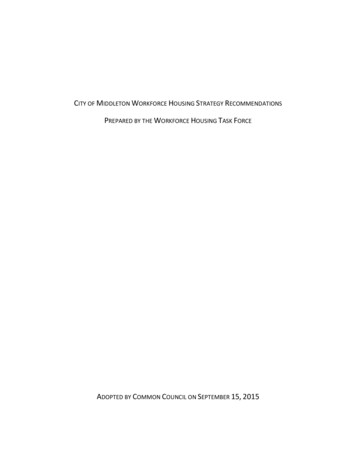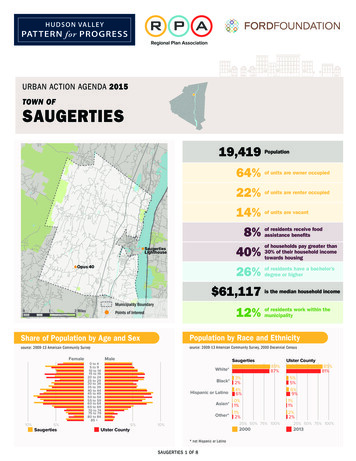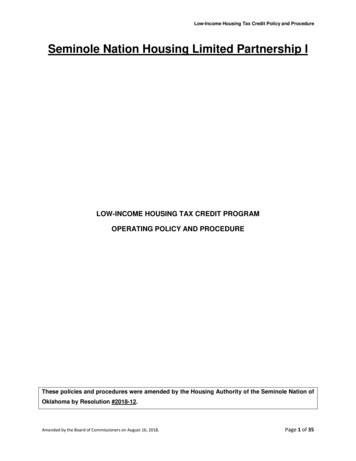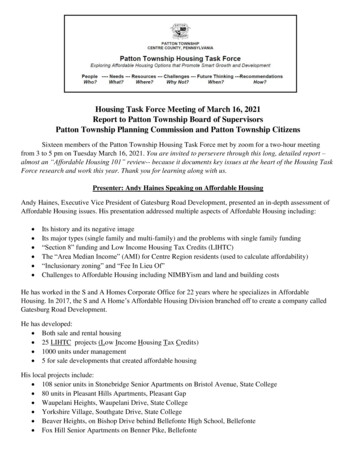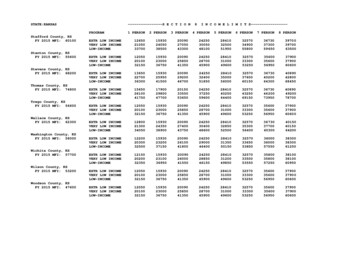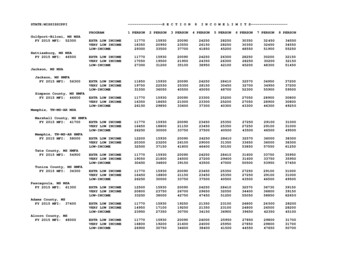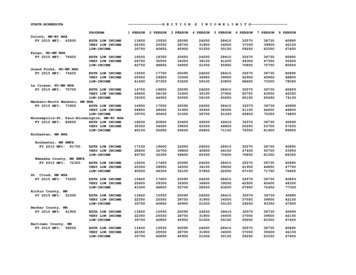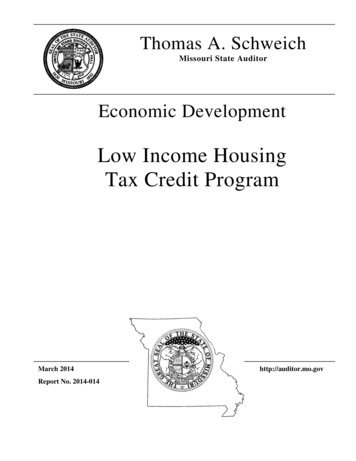
Transcription
Thomas A. SchweichMissouri State AuditorEconomic DevelopmentLow Income HousingTax Credit ProgramMarch 2014Report No. 2014-014http://auditor.mo.gov
March 2014Thomas A. SchweichMissouri State AuditorCITIZENS SUMMARYFindings in the audit of the Department of Economic Development, Low IncomeHousing Tax Credit ProgramBackgroundThe Department of Economic Development (DED), Missouri Low IncomeHousing Tax Credit (LIHTC) Program started in 1990. The MissouriHousing Development Commission (MHDC) manages this tax creditprogram, which is designed to supplement the federal LIHTC. Tax creditsmust be used for new construction, rehabilitation, or acquisition andrehabilitation. The LIHTC is the state's largest tax credit program and had 144 million in redemptions in fiscal year 2013.Program Cost and EfficiencyWhile the LIHTC program has helped provide thousands of units ofaffordable housing for low income Missourians, options exist to improve theefficiency of the tax credit model. Annual redemptions are projected toincrease to and remain around 200 million per year through 2018. Of the10 states with state LIHTC programs, Missouri ranked highest in stateLIHTC funding, and was one of only two states with a per capita rateexceeding 20. Six states had per capita rates of 5.14 or less. Actual stateLIHTCs issued and redeemed have greatly exceeded 1997 MHDCprojections provided to the General Assembly. In the fiscal note, the MHDCestimated the average allocation rate would be 50 percent of the federalcredit, but the MHDC has allocated essentially 100 percent of the federalamount since 1998. Since fiscal year 1997, the MHDC has authorized 842million more LIHTCs than projected. The MHDC has taken action to reducecosts by implementing some of the recommendations in our prior LIHTCaudit.Currently, only 0.42 of every tax credit dollar issued actually goes towardthe construction of low income housing; the remainder goes to the federalgovernment in the form of increased federal income taxes; to syndicationfirms; and to investors. The MHDC could improve the efficiency ofMissouri's LIHTC by (1) converting to a certificated credit model (possiblycombined with the use of not-for-profits or government entities to eliminatefederal taxation), (2) making the credits refundable, (3) using a directappropriation to fund low income housing directly from state revenues, alsoutilizing not-for-profit organizations or government entities, and (4)reducing the number of years over which the tax credits are spread.The program has no sunset provision. By adopting a sunset provision for theLIHTC program, the General Assembly could better determine whether theprogram is achieving its intended purpose and whether program fundinglevels are appropriate. In addition, state law allows claiming the sameproject costs under two or more tax credit programs. This "stacking" of taxcredits can be lucrative for developers, but generates no additional economicactivity or state benefit.
Economic ImpactThe economic impact of the LIHTC program reported to the legislature bythe DED is likely overstated. The department's analysis assumes no lowincome housing construction would occur if not for the state credit;however, since the federal LIHTC is available, some low income housingactivity would likely occur even without the state LIHTC program.Moreover, even considering the overstatement, the LIHTC program resultsin a very low return on investment. The fiscal year 2013 analysis shows theprogram returned 0.08 in state revenue for every dollar spent and createdapproximately 63 new full-time jobs. With redemptions of 144 million in2013, the program costs the state approximately 61,000 per unit of housingor 2.3 million per job.In the areas audited, the overall performance of this program was Fair.**The rating(s) cover only audited areas and do not reflect an opinion on the overall operation of the entity. Within that context, therating scale indicates the following:Excellent:The audit results indicate this entity is very well managed. The report contains no findings. In addition, ifapplicable, prior recommendations have been implemented.Good:The audit results indicate this entity is well managed. The report contains few findings, and the entity has indicatedmost or all recommendations have already been, or will be, implemented. In addition, if applicable, many of theprior recommendations have been implemented.Fair:The audit results indicate this entity needs to improve operations in several areas. The report contains severalfindings, or one or more findings that require management's immediate attention, and/or the entity has indicatedseveral recommendations will not be implemented. In addition, if applicable, several prior recommendations havenot been implemented.Poor:The audit results indicate this entity needs to significantly improve operations. The report contains numerousfindings that require management's immediate attention, and/or the entity has indicated most recommendations willnot be implemented. In addition, if applicable, most prior recommendations have not been implemented.All reports are available on our Web site: auditor.mo.gov
Missouri Low Income Housing Tax Credit ProgramTable of Contents2State Auditor's ReportIntroductionManagement AdvisoryReport - State Auditor'sFindingsAppendicesBackground .4Scope and Methodology.81. Program Cost and Efficiency .112. Economic Impact.16ABCLow Income Housing Tax Credit Activity.18Per Capita Low Income Housing Funding by State .19Tax Credit Redemptions.201
THOMAS A. SCHWEICHMissouri State AuditorHonorable Jay Nixon, GovernorandKip Stetzler, Acting Executive DirectorMissouri Housing Development CommissionandMike Downing, DirectorDepartment of Economic DevelopmentJefferson City, MissouriWe have audited certain operations of the Missouri Low Income Housing Tax Credit Program infulfillment of our duties under Chapter 29, RSMo and Section 620.1300, RSMo. The scope of our auditincluded, but was not limited to 2 years ended June 30, 2013. The objectives of our audit were to:1.Analyze the costs and benefits of the program to determine if it is an effective andefficient use of state resources.2.Evaluate the internal controls over significant management and financial functions relatedto the program.3.Evaluate compliance with certain legal requirements related to the program.4.Evaluate the economy and efficiency of certain management practices and operations.For the areas audited, we (1) determined the current program structure is an inefficient method of fundinglow income housing activity, but due to weaknesses in program data, other aspects of programeffectiveness and efficiency could not be adequately determined, (2) identified no deficiencies in internalcontrols, (3) identified no significant noncompliance with legal provisions, and (4) identified the need forimprovement in management practices and procedures.Except for the matter discussed in the last paragraph of the Scope and Methodology, we conducted ouraudit in accordance with the standards applicable to performance audits contained in GovernmentAuditing Standards, issued by the Comptroller General of the United States. Those standards require thatwe plan and perform our audit to obtain sufficient, appropriate evidence to provide a reasonable basis forour findings and conclusions based on our audit objectives. We believe that the evidence obtainedprovides such a basis.2
The accompanying Management Advisory Report presents our findings arising from out audit of theMissouri Low Income Housing Tax Credit Program.Thomas A. SchweichState AuditorThe following auditors participated in the preparation of this report:Deputy State Auditor:Director of Audits:Audit Manager:In-Charge Auditor:Audit Staff:Harry J. Otto, CPAJohn Luetkemeyer, CPARobert Showers, CPA, CGAPRex Murdock, M.S.Acct.Wayne Kauffman, MBAColby Dollens3
Missouri Low Income Housing Tax Credit ProgramMissouri Low Income Housing Tax Credit ProgramIntroductionIntroductionBackgroundMissouri Low Income Housing tax credit (LIHTC) program started in 1990and is established under Section 135.350 to 135.363 RSMo. The tax credithas no sunset or expiration date. The Missouri Housing DevelopmentCommission (MHDC)1 manages this tax credit program that is designed tosupplement the federal LIHTC, which began in 1986. Tax credits must beused for new construction, rehabilitation, or acquisition and rehabilitation.The LIHTC had 144 million in redemptions in fiscal year 2013, making itthe state's largest tax credit program. See Appendix C for redemptioninformation on all state tax credits.The Internal Revenue Service (IRS) allocates federal LIHTCs2 to each statebased on population. The funding level was 1.75 per capita in 2002 and hasbeen adjusted annually for inflation beginning in 2003. For 2013, federalfunding levels were 2.25 per capita, which for Missouri equals 13.5million (per year for 10 years). Guidelines for the federal LIHTC arecontained in Section 42 of the IRS tax code.Owners of a project to which the federal credit is allocated receive a federalcredit equal to 9 percent of the qualified basis3 of the project for 10 years.Projects financed with tax-exempt bonds receive a federal tax credit equal to4 percent of the qualified basis.4 Projects seeking 9 percent credits areawarded on a competitive basis. Projects seeking 4 percent credits havehistorically been awarded based on the availability of tax-exempt bondfinancing. Starting in 2007, the MHDC implemented a process thatprioritizes 4 percent project applications to help ensure the best projectsreceive priority access to available bond funding.In 1990, Missouri began supplementing the federal program by allocatingstate income tax credits equal to 20 percent of the federal total. In 1994, thestate credit increased to up to 40 percent of the federal credit for areas thatlost housing in the 1993 flood. In 1997, the state credit increased to up to100 percent of the federal credit for all areas and remains at that level.1The MHDC includes the Governor, Lieutenant Governor, Attorney General, State Treasurerand six persons appointed by the governor with the advice and consent of the Senate. AnExecutive Director manages MHDC operations. MHDC is part of the Department ofEconomic Development.2The allocation relates to 9 percent projects only.3Qualified basis is the total cost to develop the property, less items not subject todepreciation (land and reserves) and the cost of market rate units. A project's qualified basismay be increased by 30 percent if it is located in a difficult to develop area as determined bythe federal Department of Housing and Urban Development (HUD).4Actual tax credit rates are not exactly 9 percent and 4 percent, and vary on a monthly basis.The tax credit rate is determined so that the actual expected present value of the subsidy overthe 10-year period equals 70 percent of the project's eligible basis in the case of the 9 percentcredit, and 30 percent for the 4 percent credit. The rates are calculated and released monthlyby the United States Treasury.4
Missouri Low Income Housing Tax Credit ProgramIntroductionThe credit is limited to a percentage of the qualified basis, based upondepreciable basis, and the percentage of affordable units in the development.The minimum number of qualifying units is (1) 40 percent of the totalnumber of units affordable to persons at 60 percent of the median income or(2) 20 percent affordable to persons at 50 percent of the median income.Missouri's annual Qualified Allocation Plan (QAP) establishes the selectioncriteria, federal preferences, and MHDC priorities for proposal selection.Congress has delegated the administration of the federal LIHTC to statehousing agencies (the MHDC in Missouri) to assure that good qualityhousing would be available where it is most needed. The MHDC isresponsible for the allocation of federal and state credits and assuringcompliance with the regulations. The compliance process includes periodicphysical inspections of the property as well as reviews of management andoccupancy procedures during a minimum 15-year compliance period.The tax credit is non-refundable,5 and non-transferable. Section 135.352.4,RSMo, allows the credits to be carried back 3 years to offset prior taxliability or carried forward for 5 years to offset future tax liability. The taxcredits are used by investors who must acquire an ownership interest in thedevelopment partnership and may be redeemed against state income tax,corporate franchise tax, financial institution tax, or insurance companypremium tax.Housing tax credits in otherstatesMissouri is one of 13 states that have established state tax credits forhousing. Seven states6 utilize a state LIHTC in addition to the federal credit,three states7 utilize a contribution credit that is dependent upon contributionsto not-for-profit organizations, and three states (Arkansas, Missouri, andVermont) use a combination of a LIHTC and contribution credit. Missouri'scontribution credit is called the Affordable Housing Assistance Program,and is separate from the state LIHTC program. Of the 10 states that utilize astate LIHTC, six use a 10-year credit period like Missouri, while four use ashorter timeframe. See Appendix B for 2012 funding information on eachstate utilizing a LIHTC.Application and approvalprocess for state and federalcreditsDevelopers (for-profit and not-for-profit) are eligible to apply for taxcredits. Applicants must demonstrate prior, successful housing experienceand engage the services of housing professionals, such as architects,attorneys, accountants, contractors, and property managers withdemonstrable tax credit and housing experience. Developers must have the5The tax payer must have a tax liability the credit can be offset against.States that utilize only a state LIHTC in addition to the federal credit are California,Georgia, Hawaii, Massachusetts, New York, North Carolina, and Utah.7States that utilize only the contribution credit are Connecticut, Illinois, and New Mexico.65
Missouri Low Income Housing Tax Credit ProgramIntroductionfinancial capacity to successfully complete and operate the proposedhousing development. Proposed housing developments must: Meet a demonstrated affordable housing needProvide housing for low income persons and familiesDemonstrate local supportLeverage tax credit funding with other financing and/or rentalassistanceBe economically feasibleBalance sources and uses of fundsThe MHDC sets the application and selection schedule annually. Typically,a Notice of Funding Availability is published during the month of June.Once the notice is released, an application packet is available on the MHDCwebsite or by mail. The deadline for proposal submission is typically in lateSeptember, and MHDC staff make recommendations to the commission inDecember. The MHDC sets project cost limits at 125 percent of establishedHUD guidelines for 8 designated metropolitan areas8 in the state; with anyprojects outside these areas limited to 100 percent of the HUD guidelinecost limit. Tax credits are issued to approved project owners over a 10-yearperiod once the housing is ready for occupancy, which is typically 2 yearsafter project approval. The MHDC will not approve projects for stateLIHTCs without also approving the project for federal credits. Projects aregenerally limited to 7 million9 in state credits and 7 million in federalcredits. The state credit has the same guidelines as the federal credit.Tax credit sale andinvestment processDevelopers typically recruit investors to become part of a limitedpartnership arrangement where tax credits are transferred. The arrangementis often administered by a syndicator who is responsible for ensuring projectcompliance with federal tax code rules. Several of the more activesyndicators in the state are directly affiliated with developers who are alsoactive in the program. As a general partner, the developer has a smallownership percentage in the project, but has the authority to build andmaintain the project on a day to day basis. The investors, as limited partners,have a large ownership percentage in the project with an otherwise passiverole. Investors look at the credit, which can be used to offset tax liabilities,as part of their return on investment. Investors may also receive tax benefitsrelated to project operating losses, interest on debts, and deductions such asdepreciation and amortization.8The eight designated metropolitan areas established are Jefferson City, Columbia, St. Louis,Springfield, McDonald County, Kansas City, St. Joseph, and Joplin.9 700,000 in annual credits over 10 years.6
Missouri Low Income Housing Tax Credit ProgramIntroductionSyndicators told us the investors receiving the federal tax credit are usuallydifferent than the investors receiving the state tax credits. Insurancecompanies have become big investors in LIHTC projects in Missouri andare redeeming a large portion of the state LIHTCs. The insurance companiesuse the credits to offset insurance company premium taxes.Tax credit recaptureMHDC staff monitors compliance with federal LIHTC requirements. If noncompliance is identified the owner has up to 45 days to correct the problem,unless an extension is granted. MHDC staff will re-inspect the project,evaluate the status of the compliance problem and file a report with the IRSregardless of whether or not the problem was corrected. Reporteduncorrected non-compliance issues may result in recapture of a portion offederal and state tax credits redeemed on the projects. IRS staff determinesif federal LIHTCs will be recaptured.State law10 mirrors the federal law regarding recapture of tax creditsProjects receiving federal LIHTC allocations since 1987 must comply witheligibility requirements for a period of 15 taxable years, beginning with thefirst taxable year of a project's credit period. Projects receiving creditallocations after December 31, 1989 are required by the IRS code to complywith eligibility requirements for an additional 15 years beyond the initial 15year compliance period, a total of 30 years. This additional 15-year period isreferred to in the IRS code as the "extended use period." However, after theinitial 15-year compliance period some low income housing projects may beeligible11 for conversion to market-based rents if the property owner choosesto opt out of the low income housing program.Tax credits authorizedredeemedThe MHDC has authorized an average of 143.4 million in credits per yearin 9 percent state credits for fiscal years 2012 and 2013, with the sameamount being authorized in federal credits, while redemptions averaged 154 million per year. In addition, while the annual level of 4 percentcredits was limited to 60 million with a legislative change in 2009, theMHDC authorized an average of 38.6 million per year in 4 percent statecredits during fiscal years 2012 and 2013. In contrast, 4 percent tax creditauthorizations averaged 89.7 million per year for the 5 years prior to thelegislative change. Appendix A, lists detailed information of creditsauthorized and redeemed by fiscal year, and cumulative credits outstandingor pending issuance.10Section 135.355, RSMo.Depends on the other types of financing besides tax credits used on the project and otherconditions.117
Missouri Low Income Housing Tax Credit ProgramIntroductionLow income housing unitsbuiltApproximately 46,700 low income housing units have been approved forconstruction using the state LIHTC since 1998.12 The table below lists thenumber of units approved with state LIHTC during the 5 years endedJune 30, 2013.Low income units approved bycredit type - state fiscal years2009 through 2013Type9 Percent4 tal5,5694,2009,769Source: MHDC dataReportingThe DED provides the General Assembly and the public key programinformation for the LIHTC program through the tax credit activity report.Agencies administering tax credit programs are required under Section33.282, RSMo, to submit the estimated amount of tax credit activity for thenext fiscal year to the State Budget Director for submission to the Chairmenof the Senate Appropriations and House Budget Committees. In addition tothe estimates of tax credit activity, the agencies must also include a costbenefit analysis of the program for the preceding fiscal year. The annualestimates and cost-benefit analyses are submitted on forms called tax creditactivity reports. State law requires the tax credit activity report be submittedto the State Budget Director by October of each year and to the Chairmen ofthe Senate Appropriation and House Budget Committees by January 1 eachyear.Scope andMethodologyTo gain an understanding of the performance of the state LIHTC program,we interviewed various individuals involved in all aspects of the program,including MHDC staff, developers and their representatives, tax attorneys,an architect; representatives of three syndication firms, a lobbyistrepresenting developers, and a Certified Public Accountant with a firminvolved in the program. We also discussed tax credit redemptions with arepresentative of the Department of Revenue (DOR), and discussed taxcredit reporting with representatives of the Department of EconomicDevelopment (DED). Our review also included visits to two completedLIHTC project sites.We obtained data from MHDC staff on the number of housing unitsapproved by the commission, and the number of projects converted tomarket-based housing during the 5 years ended June 30, 2013. We alsoobtained information on tax credit authorizations from MHDC staff and taxcredit redemptions from MHDC and DOR staff.12Data prior to 1998 was not obtained due to the time required for MHDC staff to compile it.8
Missouri Low Income Housing Tax Credit ProgramIntroductionTo understand how Missouri's state LIHTC program compares to theLIHTC programs of other states, we obtained information from varioussources, including interviews with state housing agency representatives withthe states of Arkansas, California, Connecticut, Georgia, Hawaii, Illinois,Massachusetts, New Mexico, New York, North Carolina, Utah, andVermont.To develop projections of future tax credit activity and liability, wereviewed historical trends in tax credits awarded, authorized, issued andredeemed including data presented in Appendix A. We also reviewedhistorical information related to the federal LIHTC allocation, includingpopulation and allocation rates. We based projections for future years onhistorical trends, with an emphasis on more recent history. Future 4 percenttax credit activity is limited to a maximum issuance of 60 million per year( 6 million per year for 10 years).To evaluate aspects of program management, we reviewed the projectselection process, project cost review process, and planning process todetermine the state's long-term housing needs. We also reviewed the annualLIHTC cost-benefit analysis the MHDC reports to the legislature as part ofthe state budget process. In addition, we compared Missouri's program tobest practices established by the National Council of State HousingAgencies.To evaluate potential improvements to the program, we reviewed reportsfrom the Missouri Tax Credit Review Commission. The commission wascreated by the Governor in July 2010, and charged with reviewing the state'stax credit programs and making recommendations for greater efficiency andenhanced return on investment. The commission released reports inNovember 2010 and December 2012.13To evaluate state LIHTC recapture procedures, we interviewed MHDC staffand obtained information from MHDC on project non-compliance reportedto the IRS during the 2 years ended June 30, 2013. We tested procedures inplace to monitor ongoing projects for any noncompliance, which wouldresult in potential recapture, and observed a sample of related siteinspections.We obtained aggregate totals of annual tax credit redemptions for state taxcredits and recaptured LIHTCs for fiscal years 2008 through 2012 from theDOR. In accordance with the Missouri Supreme Court decision in the caseof Director of Revenue v. State Auditor 511 S.W.2d 779 (Mo. 1974),auditors are not provided individual tax returns. As a result, auditors were13The December 2012 report included a supplemental report that we also reviewed.9
Missouri Low Income Housing Tax Credit ProgramIntroductionnot able to verify the completeness and accuracy of redemption dataprovided.10
Missouri Low Income Housing Tax CreditLow Income Housing Tax CreditManagement AdvisoryMissouriReportManagementAdvisory Report - State Auditor's FindingState Auditor's Findings1. Program Cost andEfficiencyWhile there is no dispute the Low Income Housing Tax Credit (LIHTC)program has helped provide thousands of units of affordable housing forlow income Missourians, this audit evaluates the economic efficiency of thecurrent program. Missouri leads the nation in state LIHTC spending, on aper capita basis, and the amount of tax credits issued for low incomehousing has exceeded initial fiscal note projections. Options exist toimprove the efficiency of the tax credit model, since currently only 0.42 ofevery tax credit dollar issued goes toward the construction of low incomehousing, with the remainder going to the federal government in the form ofincreased federal income taxes, to syndication firms, and to investors. Inaddition, the program has no sunset provision and applicants can receivemultiple tax credits for the same expenditures.1.1 Total program costsIn 2012, Missouri ranked highest in state LIHTC funding, with 28.60 spenton a per capita basis. Of the 10 states with state LIHTC programs, Missouriwas one of only two states with a per capita rate exceeding 20, while 6states had per capita rates of 5.14 or less.2012 Per Capita Funding forStates with State LIHTCPrograms 35 30 25 20 15 10 5 0Source: SAO analysisProjection of future tax credit Based on actual tax credits awarded in recent years, we projected tax creditsto be authorized, redeemed, and outstanding through 2018. Assuming taxactivitycredits are awarded at a pace consistent with prior years, our projectionsestimate a cumulative total of 3.4 billion in credits will be authorized andapproximately 2.1 billion in credits will be redeemed, leaving an estimated 1.3 billion in credits outstanding or pending issuance by 2018. The charton the following page depicts actual credits authorized and redeemed from2004 through 2013, and projected authorizations and redemptions through2018. Annual redemptions are projected to increase to and remain around 200 million per year through 2018.11
Missouri Low Income Housing Tax CreditManagement Advisory Report - State Auditor's FindingActual and estimated LIHTCauthorized and redeemed Fiscal year 2004 to 2018 350 300 250 200 150 100 50 02004 2005 2006 2007 2008 2009 2010 2011 2012 2013 2014 2015 2016 2017 2018AuthorizedRedeemedSource: SAO projections based on MHDC and DOR dataLimits on total tax creditsissued are highMissouri's annual limit on 9 percent LIHTCs is significantly higher than allbut one of the other 9 states with state LIHTC programs. State law limits theamount of 9 percent credits to 100 percent of the federal LIHTC allocation.All 10 states with state LIHTC programs limit the annual amount of creditsauthorized. Missouri is one of 4 states that utilizes a percentage of thefederal allocation to determine the annual limit. While Missouri and Georgiaauthorize credits of 100 percent of the federal allocation, Hawaii limits stateLIHTCs to 50 percent, and Utah to only 10 percent of the annual federalallocation. The remaining 6 states utilize some form of set dollar value limit.Prior to 1997, Missouri law14 primarily limited the annual amount of statecredits to 20 percent of the federal allocation. In 1997, the law was changedto allow the MHDC to authorize up to 100 percent of the federal allocation.Missouri law15 currently limits the amount of 4 percent credits to 60million per year.Credits issued and redeemed Actual state LIHTCs issued and redeemed have greatly exceeded 1997MHDC projections provided to the General Assembly. In 1997, state lawexceed MDHC projectionschanged to increase the state credit to up to 100 percent of the federal credit.In the final fiscal note to the house bill, MHDC staff reported state creditswould continue to be allocated at 20 percent of the federal credit in mostparts of the state, but the MHDC would increase the allocation to 100percent in rural areas and areas where it is difficult to develop affordablehousing. MHDC estimated in the fiscal note the average allocation ratewould be 50 percent of the federal credit. However, the MHDC hasallocated essentially 100 percent of the federal amount since 1998. Inaddition, the estimate did not consider increases in the amount of annualfederal LIHTCs available for 9 percent projects, and did not consider anyestimate of credits issued for 4 percent projects. In total, since fiscal year1415Section 135.352.2, RSMo.Section 135.252.3, RSMo.12
Missouri Low Income Housing Tax CreditManagement Advisory Report - State Auditor's Finding1997, the MHDC has authorized 842 million more LIHTCs than projected(based on the average annual authorizations estimated in the 1997 fiscalnote).Prior recommendationsimplemented1.2 EfficiencyThe MH
Audit Staff: Wayne Kauffman, MBA Colby Dollens. 4 Missouri Low Income Housing Tax Credit Program Introduction Missouri Low Income Housing tax credit (LIHTC) program started in 1990 and is established under Section 135.350 to 135.363 RSMo. The tax credit has no sunset or expiration date. The Missouri Housing Development Commission (MHDC)1 manages this tax credit program that is designed to .
